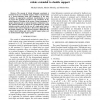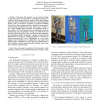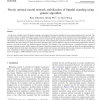119 search results - page 20 / 24 » Data-driven biped control |
CDC
2009
IEEE
13 years 11 months ago
2009
IEEE
The concept of virtual holonomic constraints is extended to the case of double support, which is characterized by a closed kinematic chain and redundancy in the state variables. An...
CONNECTION
2004
13 years 7 months ago
2004
The Artificial Life approach to Evolutionary Robotics is used as a fundamental framework for the development of a modular neural control of autonomous mobile robots. The applied e...
SIGGRAPH
2010
ACM
14 years 7 days ago
2010
ACM
This paper introduces an approach to control of physics-based characters based on high-level features of movement, such as centerof-mass, angular momentum, and end-effectors. Obje...
ICRA
2005
IEEE
14 years 1 months ago
2005
IEEE
— This paper first presents a novel control strategy for periodic motion control based on a Hamiltonian system. According to the strategy, hybrid symmetric orbits (ideal walking...
EAAI
2007
13 years 7 months ago
2007
In this work, stability control of bipedal standing is investigated. The biped is simplified as an inverted pendulum with a foot-link. The controller consists of a general regres...



